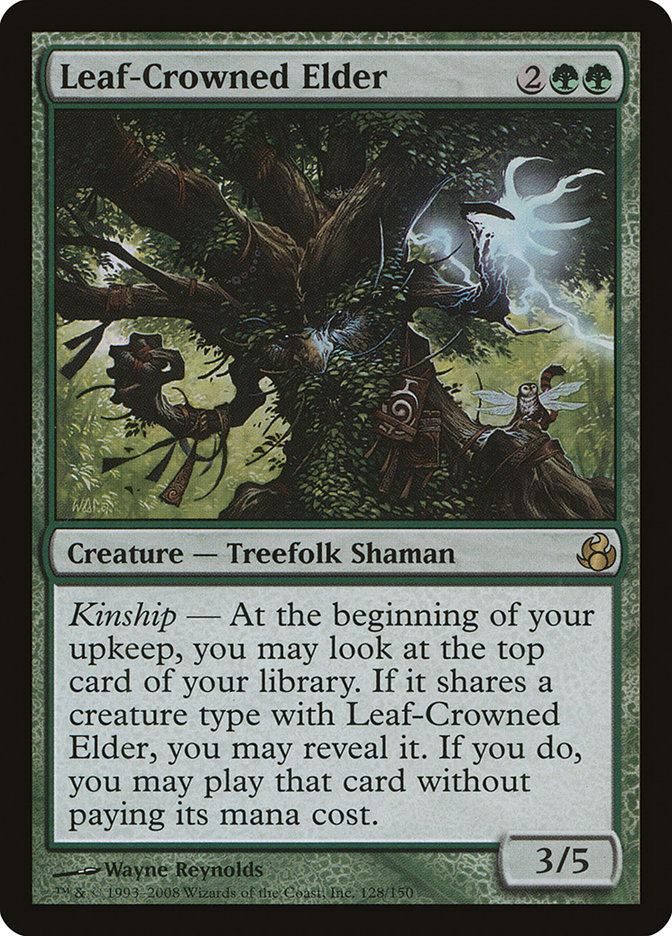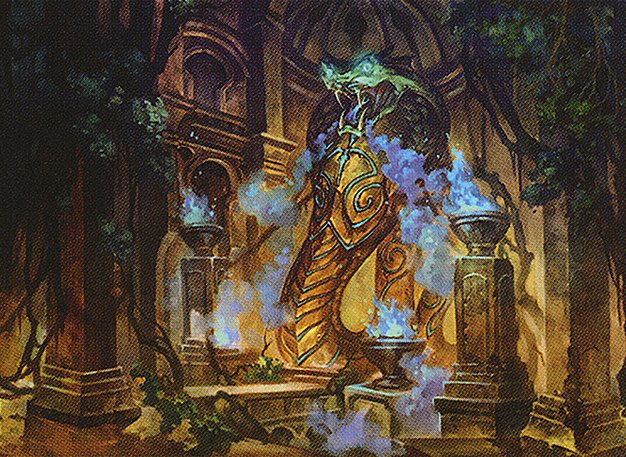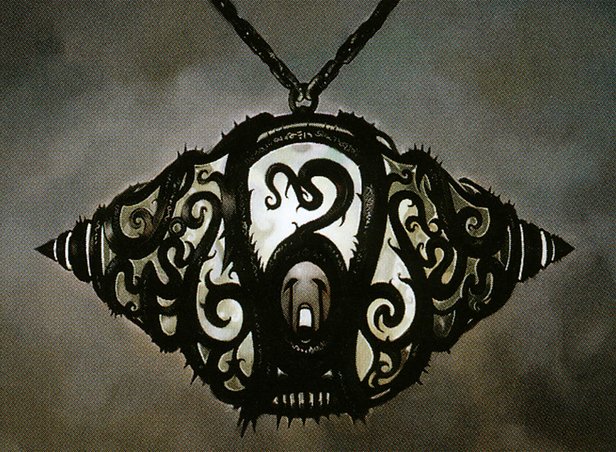Leaf-Crowned Elder MTG Card
| Card sets | Released in 2 setsSee all |
| Mana cost | |
| Converted mana cost | 4 |
| Rarity | Rare |
| Type | Creature — Treefolk Shaman |
| Abilities | Kinship |
| Power | 3 |
| Toughness | 5 |
Key Takeaways
- Provides card advantage through potential free creature plays each upkeep, bolstering Kithkin and Treefolk tribal decks.
- Resource acceleration enables casting creature spells at no mana cost, offering strategic edge in gameplay dynamic.
- Instant speed “casting” from kinship challenges traditional play, creating unexpected turns and maintaining hand resources.
Text of card
Kinship At the beginning of your upkeep, you may look at the top card of your library. If it shares a creature type with Leaf-Crowned Elder, you may reveal it. If you do, you may play that card without paying its mana cost.
Card Pros
Card Advantage: Leaf-Crowned Elder is a strategic cornerstone for any deck leveraging the Kithkin or Treefolk tribes. Its kinship ability grants you a potential free creature on top of your normal draw, keeping your hand full and the battlefield pressure high.
Resource Acceleration: Although the Elder itself doesn’t produce mana, playing cards for free effectively accelerates your resources. Dropping a Treefolk or Kithkin without tapping lands can give you an edge in deploying additional threats or holding up mana for surprise interactions.
Instant Speed: While Leaf-Crowned Elder’s kinship ability triggers during the upkeep, it essentially allows you to “cast” a creature at instant speed if the top card of your library shares a type with it. This plays phenomenally into strategies that want to maximize mana utilization by making impactful plays without dipping into the mana pool at crucial moments.
Card Cons
Discard Requirement: While not specific to Leaf-Crowned Elder itself, this creature card synergizes with deck strategies that may compel you to discard other cards to fulfill its kinship ability. As such, running out of hand cards can be particularly detrimental to the Elder’s effectiveness on the battlefield.
Specific Mana Cost: Leaf-Crowned Elder requires both green and another color of mana, making it less fluid in mana bases that are not tailored to a multicolored deck, potentially restricting its playability to dedicated green-inclusive tribal decks.
Comparatively High Mana Cost: With a casting cost of four mana, including one green, it competes with other potent four-mana creatures and tribal lords. Its dependence on the luck of the topdeck for its kinship ability may not be as appealing considering the immediate impact other cards at this cost could provide.
Reasons to Include in Your Collection
Versatility: Leaf-Crowned Elder can play a crucial role in tribal decks, particularly those centered around Kithkin or Treefolk. This ability to potentially cast powerful creatures for free each turn offers strategic depth to various deck builds.
Combo Potential: With the Elder, you unlock the potential for seamless combos by synergizing with cards that manipulate the top of your library. This can create a situation where you’re able to play premier creatures consistently without spending mana.
Meta-Relevance: In a meta that favors creature-based strategies, Leaf-Crowned Elder shines by offering consistent value each turn. It remains a solid choice when facing decks that struggle to handle multiple threats simultaneously.
How to beat Leaf-Crowned Elder
Leaf-Crowned Elder holds a distinctive place among kinship mechanics in Magic: The Gathering. As a creature that potentially allows you to play tribal deck cards for free, it can position an opponent for significant advantage, particularly in decks abundant with Treefolk and Shamans. To effectively counter this card, understanding its strengths and strategizing around them is crucial.
Firstly, removal spells are your prime weapon. By targeting Leaf-Crowned Elder with spells like Path to Exile or Doom Blade, you remove the threat before it can generate value. If the Elder has already hit the battlefield, mass removal such as Wrath of God can reset the playing field.
Discard effects are also potent tools. Coercing an opponent to discard cards from hand prevents the kinship ability from hitting key creatures. Thoughtseize and Inquisition of Kozilek can disrupt their game plan early on. Moreover, countering the Elder upon casting can deter the strategy altogether. Ensure to have counterspells like Counterspell or Negate at the ready.
Plan your sideboard with Leaf-Crowned Elder in mind, especially if you expect to face it in your play environment. Cards like Grafdigger’s Cage can shut down the free playability of creatures from the top of the library, while Scavenging Ooze can manage graveyards, hindering any recursion strategies that might pair with the Elder.
BurnMana Recommendations
Considering the strengths and intricacies of the Leaf-Crowned Elder, it stands as a keystone in tribal decks, particularly those featuring Kithkin and Treefolk. Whether it’s harnessing the Elder’s kinship ability for card advantage or its combo potential with library manipulation, this card can anchor a potent strategy. As valuable as it is in the right deck, understanding its limitations is just as crucial for deckbuilding and in-game decisions. With our careful insights and tactics, any MTG enthusiast can turn Leaf-Crowned Elder from a mere inclusion to a deck-defining advantage. Dive deeper with us as we explore how to optimize your gameplay and truly unleash the potential of your MTG collection.
Cards like Leaf-Crowned Elder
The Leaf-Crowned Elder stands out within the kinship mechanic realm in MTG, a unique ability that peers into the top card of your library and potentially cheats it into play. It can be compared with the likes of Descendants’ Path, which confers a similar effect without the creature’s tap requirement. However, the Elder brings the advantage of a significant body on the battlefield, a 3/5 that can serve as both an enabler and a threat.
Another kinship card, Cream of the Crop, allows for selective filtering each time a creature enters the battlefield, synergizing nicely with the Elder’s ability to reveal creatures. Both propel a tribal deck’s consistency but in differing bearings. Where the Elder may unexpectedly deliver a creature to the field, Cream of the Crop refines future draws, giving a player more control over what comes next. Wolf-Skull Shaman also employs kinship, producing wolf tokens rather than fielding creatures from the deck. While it doesn’t directly draw into your powerful creatures as Leaf-Crowned Elder can, it compensates by offering valuable board presence through token generation.
Comparing these cards, Leaf-Crowned Elder gives tribal decks a unique edge in MTG, adeptly blending board influence with the excitement and unpredictability of the kinship ability.
Where to buy
If you're looking to purchase Leaf-Crowned Elder MTG card by a specific set like Morningtide and The List, there are several reliable options to consider. One of the primary sources is your local game store, where you can often find booster packs, individual cards, and preconstructed decks from current and some past sets. They often offer the added benefit of a community where you can trade with other players.
For a broader inventory, particularly of older sets, online marketplaces like TCGPlayer, Card Kingdom and Card Market offer extensive selections and allow you to search for cards from specific sets. Larger e-commerce platforms like eBay and Amazon also have listings from various sellers, which can be a good place to look for sealed product and rare finds.
Additionally, Magic’s official site often has a store locator and retailer lists for finding Wizards of the Coast licensed products. Remember to check for authenticity and the condition of the cards when purchasing, especially from individual sellers on larger marketplaces.
Below is a list of some store websites where you can buy the Leaf-Crowned Elder and other MTG cards:
- eBay
- TCG Player
- Card Kingdom
- Card Market
- Star City Games
- CoolStuffInc
- MTG Mint Card
- Hareruya
- Troll and Toad
- ABU Games
- Card Hoarder Magic Online
- MTGO Traders Magic Online
See Magic products
Printings
The Leaf-Crowned Elder Magic the Gathering card was released in 2 different sets between 2008-02-01 and 2008-02-01. Illustrated by Wayne Reynolds.
| # | Release | Name | Code | Symbol | Number | Frame | Layout | Border | Artist |
|---|---|---|---|---|---|---|---|---|---|
| 1 | 2008-02-01 | Morningtide | MOR | 128 | 2003 | normal | black | Wayne Reynolds | |
| 2 | The List | PLST | MOR-128 | 2003 | normal | black | Wayne Reynolds |
Legalities
Magic the Gathering formats where Leaf-Crowned Elder has restrictions
| Format | Legality |
|---|---|
| Commander | Legal |
| Legacy | Legal |
| Modern | Legal |
| Oathbreaker | Legal |
| Vintage | Legal |
| Duel | Legal |
| Predh | Legal |
| Penny | Legal |
Rules and information
The reference guide for Magic: The Gathering Leaf-Crowned Elder card rulings provides official rulings, any errata issued, as well as a record of all the functional modifications that have occurred.
| Date | Text |
|---|---|
| 2008-04-01 | After the kinship ability finishes resolving, the card you looked at remains on top of your library. |
| 2008-04-01 | If the top card of your library is already revealed (due to Magus of the Future, for example), you still have the option to reveal it or not as part of a kinship ability’s effect. |
| 2008-04-01 | If you have multiple creatures with kinship abilities, each triggers and resolves separately. You’ll look at the same card for each one, unless you have some method of shuffling your library or moving that card to a different zone. |
| 2008-04-01 | Kinship is an ability word that indicates a group of similar triggered abilities that appear on _Morningtide_ creatures. It doesn’t have any special rules associated with it. |
| 2008-04-01 | The first two sentences of every kinship ability are the same (except for the creature’s name). Only the last sentence varies from one kinship ability to the next. |
| 2008-04-01 | You don’t have to reveal the top card of your library, even if it shares a creature type with the creature that has the kinship ability. |
| 2008-04-01 | You play the revealed card as part of the resolution of this ability. It’s played from your library, not your hand. You choose modes, pay additional costs, choose targets, etc. for the card as normal when playing it. Any X in the mana cost will be 0. Alternative costs can’t be paid. |













